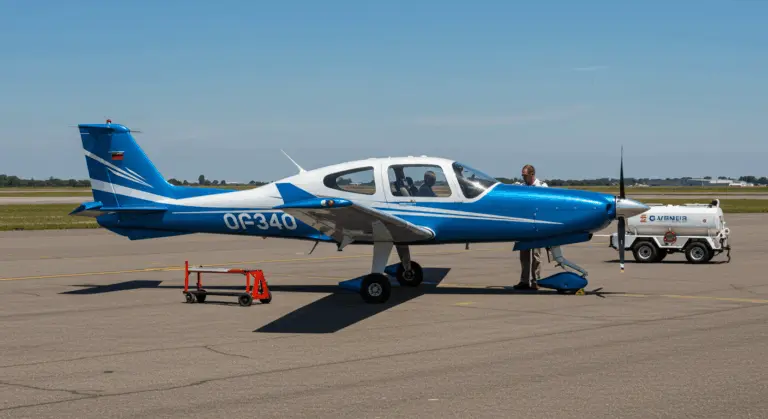Overview of the Mooney M20 Aircraft
The Mooney M20 stands as an iconic family of four-seat, piston-engine aircraft celebrated for its remarkable speed, efficiency, and unmistakable design. Created as the 20th design from Al Mooney and manufactured by Mooney International Corporation, it became his most celebrated achievement.
The Mooney M20 is immediately recognizable by several key design features:
-
Distinctive Profile: A combination of low wings, a vertical leading edge on the tail fin, and a forward-leaning stance on the ground.
-
Aerodynamic Construction: An aluminum wing skin with flush-mounted rivets to reduce drag.
-
Durable Fuselage: A steel-tube cabin structure covered in aluminum skin for enhanced strength.
The M20 series was produced in three distinct fuselage lengths:
-
Short-body: M20 through M20E
-
Medium-body: M20F through M20K
-
Long-body: M20L through M20V
The M20S Eagle, a representative model, showcases the series’ capabilities with these specifications:
-
Max Operating Altitude: 18,500 feet
-
Cruise Speed: 169 knots (195 mph)
-
Range: 721 nautical miles (with all seats filled)
-
Cabin Dimensions: 3’8″ (H) x 3’7″ (W) x 10’6″ (L)
History of the Mooney M20
Developed from the single-seat M18 Mite, the Mooney M20 took its maiden flight on September 3, 1953. Two years later, in 1955, it entered the market and established the foundation for what would become a lasting icon in general aviation.
The year 1961 marked a pivotal transformation with the M20B—the first all-metal variant. This change significantly improved both durability and performance compared to the earlier wooden-wing models.
The following year brought the M20C Mark 21, boasting an upgraded 180 hp engine that pushed performance to new heights.
In 1976, Mooney introduced the M20J, a major milestone for the series. Marketed as the Mooney 201 to highlight its 201 mph top speed achieved with only a 200 hp engine, this variant featured advanced aerodynamic improvements. A sleek new cowling and redesigned windshield delivered approximately 15% greater efficiency, cementing its status as one of the most beloved variants ever produced.
Specifications of the Mooney M20
The Mooney M20’s specifications tell a story of evolution across its numerous variants, yet certain core design elements remain consistent throughout the family. Every M20 aircraft showcases that distinctive low-wing configuration paired with retractable landing gear—creating the sleek silhouette that delivers their legendary speed and efficiency.
The landing gear system demonstrates M20 engineering quality. Crafted from heat-treated chrome-molybdenum steel, it provides an effective balance of durability and weight savings. The main gear connects directly to the wing spar, while the nose gear anchors to the tubular steel framework forming the aircraft’s structural spine.
The cabin houses four occupants, though space comes at a premium. Pilot and copilot occupy a unique position with minimal seat cushioning, positioned remarkably close to the cabin floor. This design choice contributes to the aircraft’s low profile but demands ergonomic compromises.
Performance Metrics
The Mooney M20’s performance metrics consistently distinguish it from competitors in the single-engine, four-seat category. Throughout its various iterations, the M20 has earned acclaim for delivering exceptional speed and fuel efficiency relative to engine power—making it a darling among performance-minded pilots.
Cruise speeds evolved dramatically across the M20 lineage. Early models achieved respectable 150–170 knots. The M20J pushed boundaries to 175 knots. Later variants like the Ovation and Acclaim exceeded expectations, delivering speeds from 190 knots to over 220 knots.
Range capabilities vary by model, with most variants offering 700-1,000 nautical miles with reserves—depending on power settings, altitude, and fuel capacity. This range makes the M20 well-suited for regional travel, often eliminating multiple fuel stops.
Takeoff and landing performance reveal the M20’s design trade-offs. The aircraft typically demands 1,500-2,200 feet for takeoff at sea level under standard conditions. Landing distances stretch between 2,500-3,500 feet.
Mooney M20 Community and Ownership
The Mooney M20 has cultivated one of general aviation’s most passionate and dedicated owner communities. Central to this community is the Mooney Aircraft Pilots Association (MAPA)—an organization that has supported Mooney ownership for decades. MAPA provides valuable resources: technical support, maintenance guidance, and regular publications that help owners maximize their aircraft’s potential while minimizing operating costs.
Beyond formal organizations, owners connect through various channels:
-
Online forums
-
Social media groups
-
Regional fly-ins
The community’s enthusiasm stems partly from the M20’s distinctive character, which creates a unique flying experience. Owners frequently describe their aircraft as having personalities that reward proper technique and meticulous attention to detail. This shared experience creates strong bonds among Mooney pilots that go beyond typical aircraft ownership.
For many owners, their Mooney represents far more than mere transportation—it’s a long-term relationship. You’ll find pilots who’ve owned the same M20 for decades, gradually upgrading avionics and interiors while maintaining core systems to factory specifications.
Buying a Mooney M20 – What to Consider
Purchasing a Mooney M20 is a significant investment that requires careful consideration of many factors beyond the initial price. Prospective buyers should approach the process with clear understanding of both the aircraft’s advantages and ownership responsibilities.
The first major decision involves determining which M20 variant best matches your mission profile. Earlier models like the M20C and M20J offer excellent efficiency and lower acquisition costs—but may lack the speed and modern amenities of later variants.
Budget planning must account for significant annual operating costs, which can total $15,000-$30,000 and typically include:
-
Insurance
-
Hangar or tie-down fees
-
Routine maintenance
-
Reserves for engine and propeller overhauls
Many pilots find the Mooney M20 offers excellent value compared to alternatives like the Cessna 172. It delivers significantly higher cruise speeds and superior fuel efficiency for a comparable investment. This performance advantage makes the M20 particularly attractive to pilots who prioritize cross-country capability and efficiency over the more forgiving handling characteristics of high-wing trainers.
Maintenance and Upkeep
Maintenance and upkeep are essential aspects of Mooney M20 ownership, directly impacting both safety and long-term aircraft value. The M20’s reputation for durability is well-earned, but this longevity hinges on diligent adherence to maintenance schedules and addressing issues promptly before they escalate.
Regular maintenance for the Mooney M20 follows standard inspection protocols. Annual inspections typically cost $2,000-$4,000, depending on the aircraft’s age, condition, and any discrepancies discovered during the process.
The M20’s retractable landing gear system demands particular attention during inspections. While the gear mechanism—constructed from heat-treated chrome-molybdenum steel—proves generally robust, it thrives with regular lubrication and adjustment to ensure smooth operation.
Structural considerations prove especially critical for older M20 models. The aircraft’s steel-tube cabin frame can succumb to corrosion if exposed to moisture—making thorough pre-purchase inspection essential when considering an older Mooney.
Many M20 owners find that working with Mooney-experienced mechanics provides significant benefits in both maintenance quality and cost management. These specialists understand the model’s quirks and common issues, often spotting potential problems before they become serious.

